Related Research Articles

The Boeing E-3 Sentry is an American airborne early warning and control (AEW&C) aircraft developed by Boeing. E-3s are commonly known as AWACS. Derived from the Boeing 707 airliner, it provides all-weather surveillance, command, control, and communications, and is used by the United States Air Force, NATO, French Air and Space Force, Royal Saudi Air Force and Chilean Air Force. The E-3 has a distinctive rotating radar dome (rotodome) above the fuselage. Production ended in 1992 after 68 aircraft had been built.

The Royal Air Force (RAF) is the United Kingdom's air and space force. It was formed towards the end of the First World War on 1 April 1918, becoming the first independent air force in the world, by regrouping the Royal Flying Corps (RFC) and the Royal Naval Air Service (RNAS). Following the Allied victory over the Central Powers in 1918, the RAF emerged as the largest air force in the world at the time. Since its formation, the RAF has taken a significant role in British military history. In particular, during the Second World War, the RAF established clear air superiority over Hermann Göring's Luftwaffe in the Battle of Britain, and led the allied strategic bombing effort.
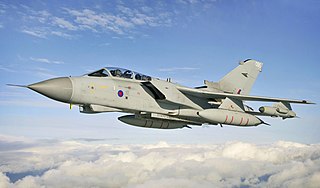
The Panavia Tornado is a family of twin-engine, variable-sweep wing multi-role combat aircraft, jointly developed and manufactured by Italy, the United Kingdom and Germany. There are three primary Tornado variants: the Tornado IDS (interdictor/strike) fighter-bomber, the Tornado ECR SEAD aircraft and the Tornado ADV interceptor aircraft.
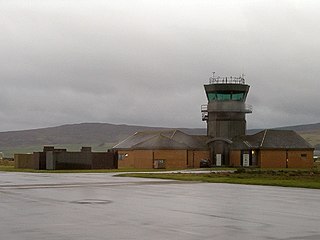
Royal Air Force Machrihanish or RAF Machrihanish is a former Royal Air Force station located near the town of Machrihanish and 3.5 miles (5.6 km) west of Campbeltown, at the tip of the Kintyre peninsula, Argyll and Bute, in Scotland.

The Third Air Force (Air Forces Europe) (3 AF) is a numbered air force of the United States Air Forces in Europe - Air Forces Africa (USAFE-AFAFRICA). Its headquarters is Ramstein Air Base, Germany. It is responsible for all U.S. air forces in Europe and Africa, and operations and support activities in the U.S. European Command and U.S. Africa Command's areas of responsibility. It also has a unique mission as the U.S. military's primary liaison to the British government, which is conducted through the command's 3 AF-UK headquarters at RAF Mildenhall, England.

Royal Air Force Fairford or more simply RAF Fairford is a Royal Air Force (RAF) station in Gloucestershire, United Kingdom. While being an RAF station, Fairford hosts United States Air Force personnel. Since 2019, the base has played host to a Lockheed U-2S Dragon Lady detachment from the 99th Expeditionary Reconnaissance Squadron. It is the USAF's only European airfield for heavy bombers and routinely supports Bomber Task Force (BTF) operations. Its most prominent use in recent years has been as an airfield for United States Air Force B-52s during the 2003 Iraq War, Operation Allied Force in 1999, and the first Gulf War in 1991.

Royal Air Force Boulmer or RAF Boulmer is a Royal Air Force station near Alnwick in Northumberland, England, and is home to Aerospace Surveillance and Control System (ASACS) Force Command, Control and Reporting Centre (CRC) Boulmer.
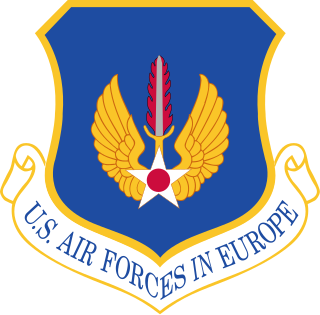
The United States Air Forces in Europe – Air Forces Africa (USAFE-AFAFRICA) is a United States Air Force (USAF) major command (MAJCOM) and a component command of both United States European Command (USEUCOM) and United States Africa Command (USAFRICOM). As part of its mission, USAFE-AFAFRICA commands U.S. Air Force units pledged to NATO, maintaining combat-ready wings based from the United Kingdom to Turkey. USAFE-AFAFRICA plans, conducts, controls, coordinates and supports air and space operations in Europe, parts of Asia and all of Africa with the exception of Egypt to achieve U.S. national and NATO objectives based on taskings by the two combatant commanders.
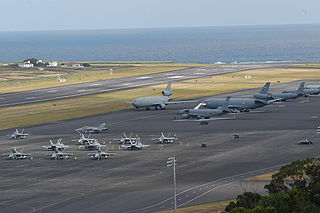
Lajes Field or Lajes Air Base, officially designated Air Base No. 4, is a multi-use airfield near Lajes and 15 km (9.3 mi) northeast of Angra do Heroísmo on Terceira Island in the Azores, Portugal. It is home to the Portuguese Air Force Base Aérea N º4 and Azores Air Zone Command, a United States Air Force detachment unit, and a regional air passenger terminal. Located about 3,680 km (2,290 mi) east of New York City and about 1,600 km (990 mi) west of Lisbon, Portugal; the base sits in a strategic location midway between North America and Europe in the north Atlantic Ocean.
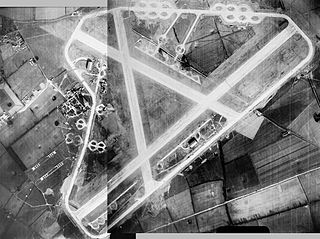
Sculthorpe Training Area, previously RAF Sculthorpe is a training site owned by the British Ministry of Defence. It is about 3 mi (4.8 km) west of Fakenham in Norfolk, England. It forms part of the Defence Training Estate.
The history of the Royal Air Force, the air force of the United Kingdom, spans a century of British military aviation.

Naval Air Station Keflavik (NASKEF) was a United States Navy air station at Keflavík International Airport, Iceland, located on the Reykjanes peninsula on the south-west portion of the island. NASKEF was closed on 8 September 2006, and its facilities were taken over by the Icelandic Defence Agency as their primary base until 1 January 2011, when the Agency was abolished and the base handed over to the Icelandic Coast Guard, which has since then operated the base. US forces would return to Keflavik starting from 2016.

Since 1942 the United States has maintained air bases in the United Kingdom. Major Commands of the USAF having bases in the United Kingdom were the United States Air Forces in Europe (USAFE), Strategic Air Command (SAC), and Air Mobility Command (AMC).

Ahmad Shah Baba International Airport, also referred to as Kandahar International Airport and by some military officials as Kandahar Airfield, KAF), is located about 9 nautical miles south-east of the city Kandahar in Afghanistan. It serves as the nation's second main international airport and as one of the largest main operating bases, capable of housing up to 250 aircraft of different sizes. The current head of the airport is Maulvi Fathullah Mansour.

The Estonian Air Force is the aviation branch of the Estonian Defence Forces. The air force traces its history to 1918, and was re-established in its current form in 1991.
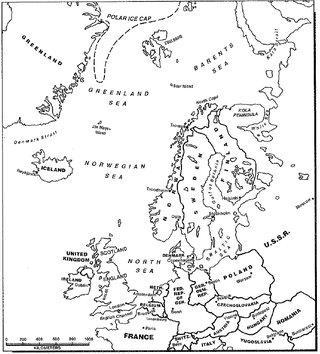
Exercise Mainbrace was the first large-scale naval exercise undertaken by the newly established Allied Command Atlantic (ACLANT), one of the two principal military commands of the North Atlantic Treaty Organization (NATO). It was part of a series of NATO exercises jointly commanded by Supreme Allied Commander Atlantic Admiral Lynde D. McCormick, USN, and Supreme Allied Commander Europe General Matthew B. Ridgeway, U.S. Army, during the fall of 1952.

Quick Reaction Alert (QRA) is state of readiness and modus operandi of air defence maintained at all hours of the day by NATO air forces. The United States usually refers to Quick Reaction Alert as 'Airspace Control Alert'.

Allied Command Channel (ACCHAN) was one of three major North Atlantic Treaty Organization (NATO) commands from 1952 to 1994. Commander-in-Chief Channel was a Major NATO Commander (MNC).
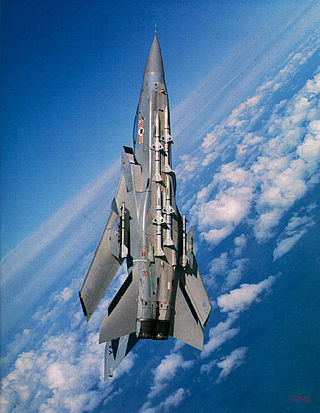
The Improved United Kingdom Air Defence Ground Environment, normally shortened to either UKADGE or IUKADGE, was the Royal Air Force's (RAF) ground-controlled interception system covering the British Isles during the 1990s. It consisted of a number of ground-based radar sites, links to airborne early warning aircraft and Royal Navy ships, a telecommunications system to send digital data and voice communications on a protected network, and processing systems based on VAX-11/780 computers. The network ultimately contained a dozen long-range radars including four Marconi Martello, two General Electric TPS-592, and six Plessey AR-320.
References
- ↑ Mains, Maj. Steven (March–April 1997). "Adapting Doctrine to Knowledge-Based Warfare" (PDF). Military Review. 77 (2). Archived from the original (PDF) on 2013-01-20. Retrieved 2007-07-24.
- ↑ "RAF STRIKE COMMAND - UK AIR SURVEILLANCE AND CONTROL SYSTEM (ASACS)" . Retrieved 2007-07-24.